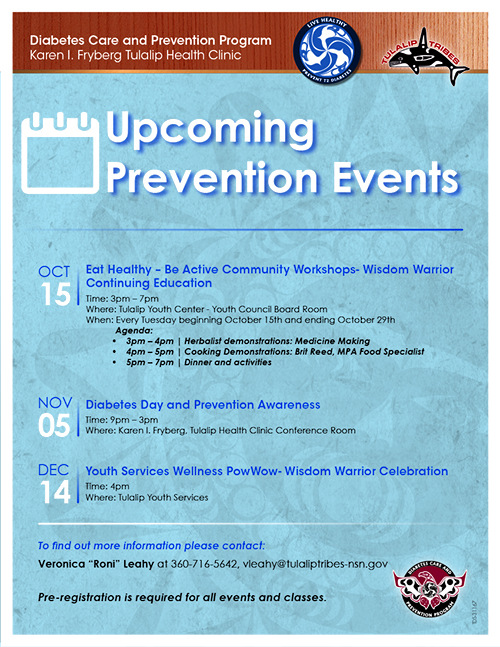
Upcoming Diabetes Prevention Events

syəcəb

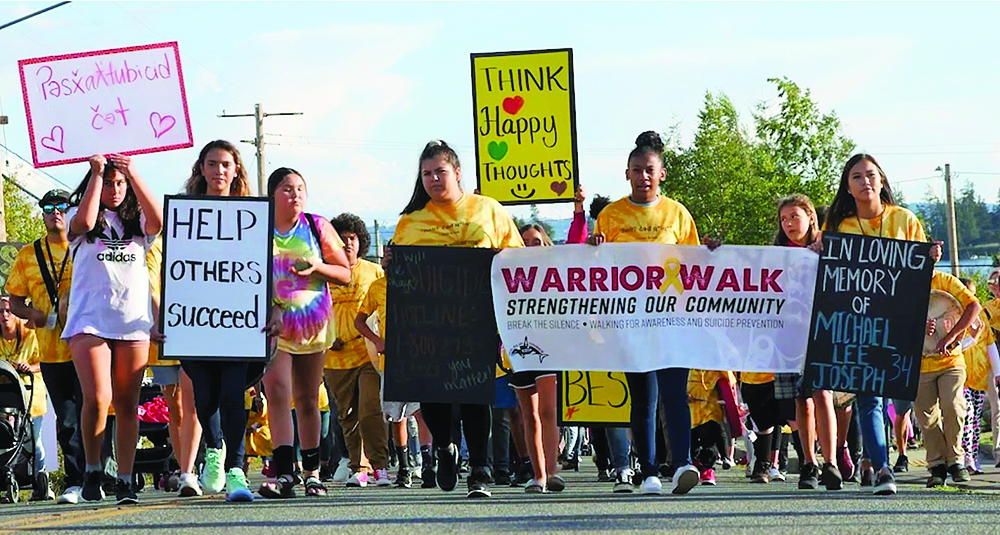
By Micheal Rios, Tulalip News
According to the World Health Organization, over 800,000 people die by suicide annually, representing 1 person every 40 seconds. It is the 2nd leading cause of death in the world for those aged 15-24 years old, and suicide among males is 4x higher than among females.
Taking one’s own life is the result of a convergence of risk factors including psychological and social risk factors often combined with experiences of trauma and loss. Although an often taboo subject, one of the best preventative measures is breaking the silence and encouraging those in distress to tell their own story in their own way and at their pace.
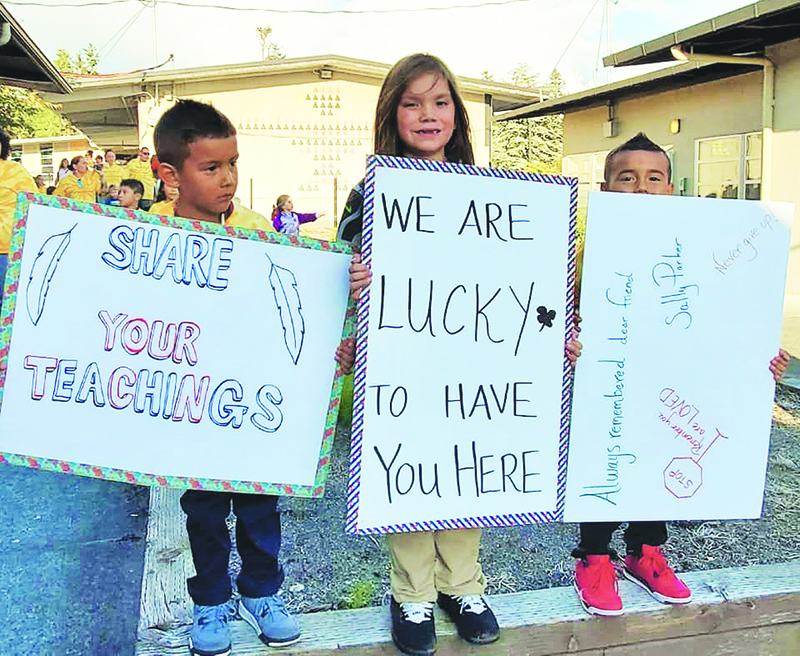
Tulalip is all too familiar with suicide, especially among the younger generation. By engaging in active listening and reaching out to those who are vulnerable we can build a more resilient and stronger community. On September 10, more than 150 supportive individuals came together to observe and publicize National Suicide Prevention Day with a community strengthening Warrior Walk.
Wearing bright yellow shirts, the symbolic color for suicide prevention, with bold text that read ‘I am alive and strong’, the group convened at the Dining Hall. While there, all concerned citizens had an opportunity to create signs with positive affirmations and empowering messages, such as ‘believe in yourself, ‘help others succeed’, and ‘you are loved’. While most signs were uplifting in nature, some were more heartfelt by being dedicated to the memories of loved ones taken too soon by suicide.
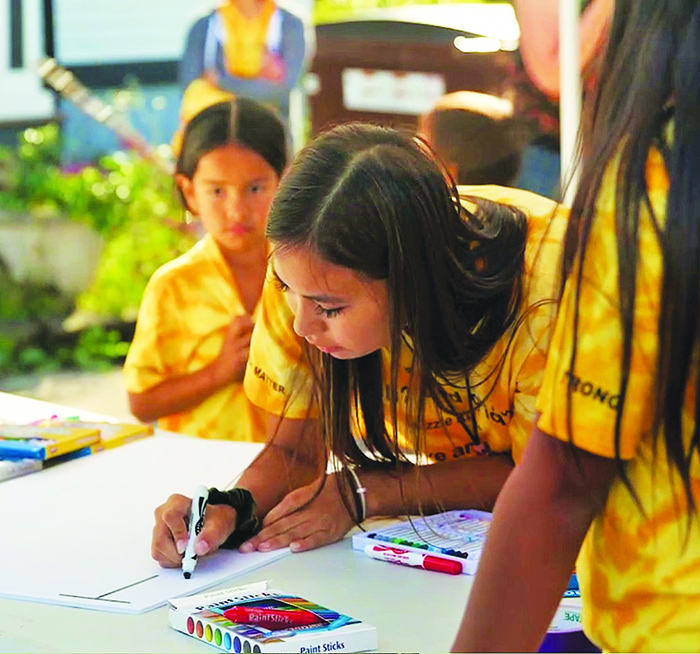
“[This] walk is a suicide prevention walk in honor of prevention month. We named it Warrior Walk because we are warriors,” explained youth councilmember Marisa Joseph. “It was attended by tribal members and family members who have been affected by suicide.
“This is important to me because suicide has affected the Tribes and my life, personally,” she added. Marisa walked with a sign that read ‘in loving memory of Michael Lee Joseph, 34’.
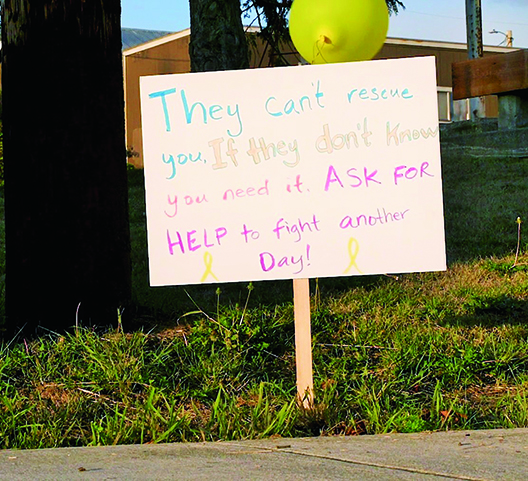
In collaboration with Community Health, Education, Youth Council and other departments, all were welcome to attend the powerful walk for suicide prevention and awareness. Whether an individual’s reason was in memory of loved ones lost, in support of those who struggle in silence, or to showcase strength and empowerment, the yellow tidal wave that started at the Dining Hall and ended at the Early Learning Academy’s gymnasium meant a great deal to those who needed it.
“To me, the Warrior Walk meant healing, not only for individuals but for our community,” shared walk participant Shawn Sanchey. “It’s bringing our strength together to help uplift one another. It showed our youth and our people that they’re loved and the community is always there for you. It’s important to me our younger generation understands that we are always here for them.”
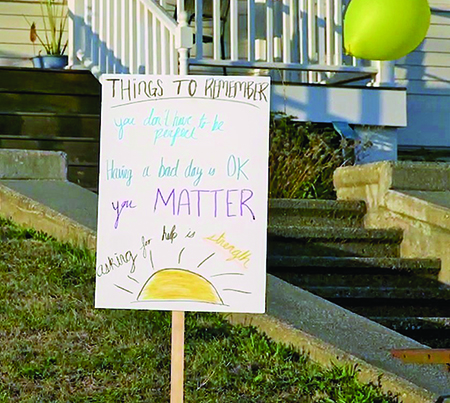
Reaching out to those most at risk in the community is critical to preventing self-harm. If you are worried about someone, please reach out and ask them, “are you okay?” By simply checking in with them and offering non-judgmental support you can make a difference. It is important to know that people in distress are often not looking for specific advice, but merely to be listened to with compassion and empathy.
“Walking together in strength and support for the youth, our elders and community members in need of healing is unity,” said Seilavena Williams, patient support executive assistant. “[There are] so many departments and divisions working together with our community in mind. By coming together the community members could feel that they are welcomed, supported and loved.”
The National Suicide Prevention Lifeline 1-800-273-8255 is a crisis resource that provides free and confidential support 24/7. Suicide is not inevitable for anyone. By starting the conversation, providing support, and directing help to those who need it, we can prevent suicides and save lives together.
As we approach the halfway mark of summer 2019, now is a good time to revisit a lesson that many of our parents and grandparents recited to us on a regular basis during this time of year: go out, get some fresh air and enjoy the sunshine.
With the Fourth of July excitement well behind us, we may be quick to find excuses to stay inside and relax in the cool A/C comfort of our homes. And of course there’s nothing wrong with that, it’s important for our bodies to decompress and recharge, but in the same breath, it is also equally important to make sure the body is getting the exercise it needs and deserves after staring at technology screens for days on end.
From the high mountain ranges to the cool coastlines of the Salish Sea, the Pacific Northwest is a nature wonderland, filled with breathtaking views and landscapes. The summer season is the perfect time to take a social media break and experience the great outdoors, to disconnect from the world and reconnect with Mother Earth, if you will.
Tulalip community member and SNAP-Ed Nutritionist, AnneCherise Jensen, set aside some time to share a few ideas on how local citizens can take advantage of the long summer days, get outdoors and have a little fun in the sun.
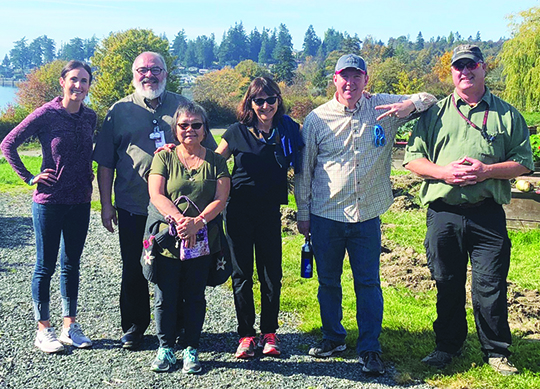
Okay, first things first. Why is exercise important for our bodies?
Exercise is the best form of preventive medicine. Our bodies are like a machine, if you don’t use it, you lose it. We need to be moving our bodies and pushing them to their fullest potential in order to keep our bodies healthy. The reason why exercise is important is because it helps take care of our organs – our heart, our lungs, our kidneys. Physical activity is medicine for the body, it helps repair itself. The more sedentary we get, the weaker our organs get. The more exercise we get, the more we’re strengthening our body, and the more resilient we’re making it to outward things that are coming inside. It helps relieve a lot of the toxins that we’re exposed to in today’s environment. The biggest reason exercise is so important is because it reduces the risk of diabetes, certain types of cancers, obesity and heart disease.
It’s summertime! The warm weather presents a great opportunity for outdoor recreation, what are some fun activity ideas the community can do before the summer ends?
One thing that I love to do is go on small little hikes throughout the summer. We live in a really nice area where we have local access to trails. There’s lots of really good ones out in Mountain Loop Highway like Coal Lake, Lake 22, Heather Lake, Mt. Pilchuck. Those are really good trails, moderate to beginner ones.
Riding bikes is awesome if you have access to fun and safe roads, same with going to the skate park. Also, going to the beach for a swim. Swimming is a really great way to exercise, burn calories, keep your cardio up and it’s real forgiving on your joints. That’s a pretty good start. If you’re feeling like you’re not very flexible or have a lot of pain, I recommend yoga or chair yoga.

For those who are interested in hiking but have never been, what type of gear is needed before retreating to the mountains?
A good pair of hiking shoes. You’re going to want something that is water resistant and has a good sole. I recommend Salomon/Arc’Teryx at the outlet mall, they have really good prices on shoes. Also Columbia, and REI is a really good place to go if you’re in the Lynnwood area. Always make sure you have your ten essentials and those include matches, water, a compass, map, food, an emergency blanket (see image for complete list). You always want to make sure you have a rain jacket when you’re up in the mountains. You never know what the weather is going to be, so you want to make sure you have a waterproof jacket that provides warmth. Always know where you’re going, read a trip report. A good source to get information like that is the Washington Trails Association at www.WTA.org
Hiking and camping often go hand-in-hand and camping is a great summertime group activity, any advice for first time campers?
There are two ways to camp; you can park and have all your gear out and camp close to your car, or you can go overnight backpacking where you pack all your overnight gear. That’s a really great experience, probably my number one favorite thing to do in the summertime is to go camping in the mountains. You want to have dehydrated food, lots of water and a water purifier so you have a clean water source. The experience is a good way to disconnect and get in tune with yourself, especially if you’re a spiritual person.
You always want to make sure you know where you’re camping and do a little research beforehand. Make sure that you set up in a designated camping spot and that you have enough food to secure you at least one day extra than you planned.
Canoe Journey is happening now and is extremely popular amongst tribal nations, what are a few tips for the canoe pullers?
When you’re out on the water, make sure you bring lots of water that have electrolytes, because a lot of time you’re in the blazing sun and sweating a lot and in order to retain the water you drink, you want to have enough sodium, potassium, magnesium, so that way you don’t get fatigued.
More important than anything, wherever you’re going, the mountains or the water, make sure you’re with a group of safe people, people you can trust and rely on. And also, follow the LNT principals, Leave No Trace, respect the outdoors and make sure you leave it better than you found it.
What are some fun ideas for folks who want to enjoy the sun in the comfort of our community?
One of my favorite things to do in the area, if you can get a fun group together, is to go on a trash cleanup. Even if you just work in your local area, community, block, or beach, grab some gloves and a couple other people and fill your bags up with trash. It’s super rewarding and fun.
If you have a dog, or even a cat, definitely walking and playing with your pet. I just got a dog this year, his name is Copper, we take him hiking in the mountains or we’ll take him to the beach. We have lots of local beach access points out here. Strawberry Fields, out in Arlington, is also a really great place to take your dog. It has a nice mile-and-a-half long trail so you’re getting some exercise yourself along with the dog.
Last but not least, I highly recommend going to the YMCA, especially if you have kids and a free membership. You can play basketball with your kids or take them swimming.
This time of year, many people can be found tending to their personal gardens and cultivating nutritious crops. Can you talk about the benefits, both physical and nutritional, there are when growing a garden?
Gardening is a great activity, even if you just have one bed. Being out with the plants helps you develop a really good relationship with the plants and food. You’re able to get some vitamin D from the sunshine and also mild physical activity, it gets you moving. Kale, potatoes and carrots are all really easy to grow and you can add those to any meal and do oven-baked vegetables.
You can also go harvesting for native plants. Harvesting is another wonderful thing to do this time of year, especially out here on the reservation. You can go out and find an area to harvest berries and you can use those to bring home and make salads or other interesting things. Everything is in season right now. I’ve noticed there’s a lot of fruit trees out here, so if you have access to a fruit tree you can gather enough to make pies, jams, desserts and fruit salads.
As you know, it’s BBQ season. Do you have any tasty recipes that people can chef up for their next cookout?
I have two recipes for BBQs! I have a strawberry mango salsa that’s yummy, you can add jalapenos, strawberries, mangos, tomatoes. You get a lot of servings of fruits and vegetables and it’s high in vitamin C too. Vitamin C is great to eat a lot of throughout the summertime, especially before the cold weather hits. You can do pico de gallo if you don’t like it with the fruit.
And fruit kabobs. We’re going to have fruit kabobs at the Tulalip Health Clinic’s annual Health Fair on July 26th. It’s a good way for kids to try new fruits that they haven’t been exposed to. Try to have ten different fruits available and you can put it on a kabob and take it with you.
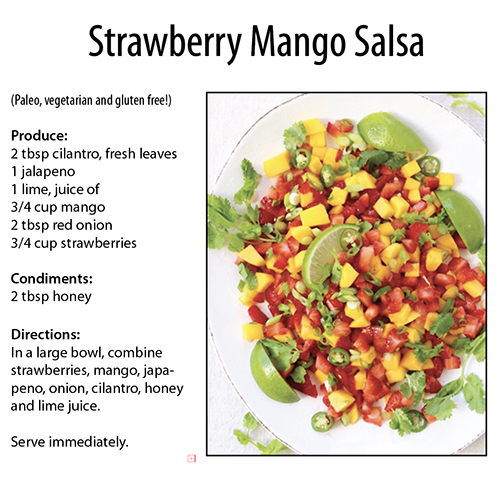
Are there any upcoming events you would like to share with our readers?
If you’re looking for more things to do at Tulalip, we have our Garden Days. Our next one is going to be August 3rd at 10:00 a.m. We always start each Garden Day with a mile-and-a-half walk. And we also have our walking club every Wednesday at noon at the Health Clinic, it’s always fun to get out there and go for a walk by the bay.
For further details, please contact SNAP-Ed at (360) 716-5632.
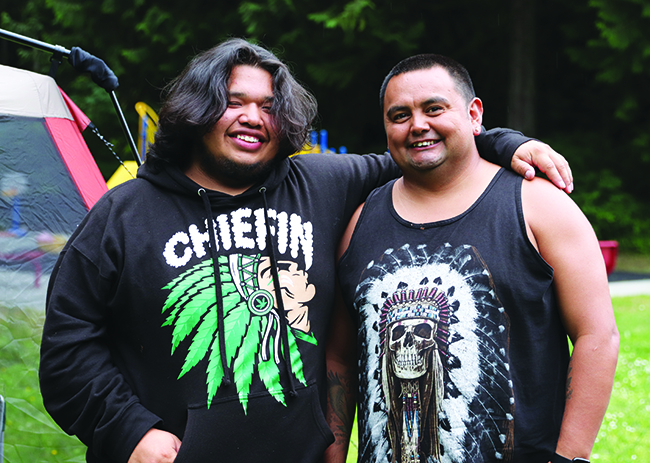
By Kalvin Valdillez, Tulalip News
On the evening of June 26, a small gathering occurred behind the Tulalip beda?chelh building. Laughter filled the air as people visited with one another in celebration of achievement in honor of the Family Haven program, Young Men’s Team Outreach. In the middle of the mix was Outreach Worker, Cody Monger, fondly reminiscing with his young clients about their successes over the past few years.
“We’re celebrating the end of our mental health grant from the North Sound BHO (Behavioral Health Organization),” said Cody. “It was a good three-and-a-half-year experience. It was a great grant that opened up a lot of doors for me to explore, to be a part of and help out our community.”
The outreach program was designed to provide support to Tulalip youth, helping teens who are facing hard times accomplish their goals and get life back on track. Through Cody’s guidance, the young men learned how to set, prioritize and accomplish both short and long term goals and were also provided assistance with recovery, physical and mental health, legal issues, obtaining a driver’s license, money management and resumes. The program also assists adolescents by promoting academics, helping dropout students re-enroll into school in order to obtain their high school diploma or GED, as well as providing a space to study every Wednesday.
Cody meets one-on-one with each of the young men on a weekly-basis, allowing them the chance to vocalize any current difficulties they are experiencing as well as celebrate any new victories. He also meets with his clients where they are most comfortable, whether it’s at the Family Haven office, home, school, a coffee shop or a restaurant. And due to the success of the young men’s outreach program, Family Haven recently established a Team Outreach for the young ladies of the community.
“Before the program, I noticed there was a lot of kids who were not being helped,” expressed Cody. “I wanted to try to make a difference in the community by helping them out in any way that I could. Now I work with the young guys, the ones who are suicidal, not connected with school or in need of services. I meet with them individually three to four times a week and also take after hour calls or texts.”
Perhaps it’s because of his young age, his sound advice or his intentions, whatever it may be, Cody has received a great response from the young Tulalip men who confide in him on a regular basis. Thanks to the funding from the North Sound BHO, the program assisted upwards of forty young men during the grant’s three-year period. This year alone, Cody managed a large caseload of about twelve clients while also keeping in contact with approximately ten more young adults, routinely checking in to make sure they are doing okay.
One client, Darrian Solomon, expressed his gratitude for the program during the event stating, “This program and Cody helped me out a lot. He’s been a reliable friend; somebody I can always talk to. He’s really helped me get through a lot.”
As one door closes, another one opens as recently the Tulalip Tribes announced they would take over the funding for the Young Men’s Team Outreach program. The transition from a grant to hard dollars allows Cody to work with larger caseloads and broader age groups as well as plan more activities and events, one idea being a weekly father’s group meet up.
“We’re really thankful that the Tribe picked this program up because otherwise it would go away,” stated Alison Bowen, Family Haven Program Manager. “Some of the things and the growth that these young guys have gone through has been really amazing to witness. Ranging from getting back into school, getting jobs, getting connected with the community and culture, it was a group of individuals who weren’t really involved with anything before and it’s exciting that this is going to continue for them.”
“It’s important for our kids to know that there is somebody out there willing to go above and beyond for them, to help them through their darkest times,” said Cody. “I know sometimes it’s hard to reach out to ask for that peer support, or help in general. It’s a good feeling for them, knowing that there are people who are genuinely looking out for what’s best for them and their future.”
For more information, please contact Tulalip Family Haven at (360) 716-4402.
By Kalvin Valdillez, Tulalip News
For its seventh consecutive year, the popular Community Wellness Conference returns to the Tulalip Resort Casino once again on May 14 and May 15. Sponsored by the Tulalip Tribes Problem Gambling Program, the two-day event invites local citizens to focus on their healing journey by providing them with tools, education and resources on how to improve overall health and wellbeing through a number of interactive workshops, professional panel discussions and community talking circles.
Approximately 200 participants attended each day of the conference in previous years, and Problem Gambling is anticipating about the same number of attendees this year. Both the Tulalip Tribes and the Marysville School District agree that self-care is of the utmost importance, especially in today’s social media led society. For this reason, the school district is allowing their students the opportunity to attend the Wellness Conference during the school day; middle school students on the first day and high schoolers on the second day. Tribal government employees are also often allotted two-hours of paid administration leave to participate in the workshops, upon supervisor approval.
“What to expect from this year’s Wellness Conference is a great gathering for the community and also for the youth,” says Community Wellness Conference Emcee and Youth Education Advocate, Deyamonta Diaz. “There’s middle and high school days where the students get a chance to be exposed to some great keynote speakers and also some helpful educational workshops that will teach them a lot of things that maybe are too hard to talk about, as far as wellness or self-care, as well as other issues we face in the community. The theme is ‘champions for life’ so it’s a positive message, something that can go a lot farther than just the conference.”
Each workshop presenter knows about the issues we face in Native America, and specifically in Tulalip, as the conference is a collaborative effort with local departments such as the Child Advocacy Center, Family Haven, Youth Services, the Education Department and Family Services. The conference aims to equip those carrying emotional, spiritual and mental baggage with the tools of how to get through their toughest days and several resources for when they’re in need of a helping hand or an ear to listen.
Since we are living in a new era, many youths now deal with cyber-bullying, stalking and harassment on social media platforms like Facebook, Twitter, YouTube, Snapchat and Instagram. The Child Advocacy Center is debuting a workshop during the Wellness Conference addressing these issues and teaching the community about the dangers occurring on social media sites.
“I’m doing a social media health and safety workshop,” says Child Advocate and Wellness Conference presenter, Megan Boyer. “I think it’s important for families of youth, and youth themselves, to learn about what the dangers are when online and how they can keep themselves safe and what parents can do to keep their kids safe. They are going to learn about some of the policies and laws about how law enforcement uses social media as evidence. They’ll learn to identify red flags, what bullying is, what consent is, how social media can be harmful and how it can be helpful, because education is key.”
Sarah Sense-Wilson, Problem Gambling Coordinator, briefly explains the topics the keynote speakers will be touching upon during the Community Wellness Conference.
She states, “Our keynote speaker for day one, Frank Grijalva, is going to be talking about resiliency, and health and wellness, as it relates to overcoming trauma and overcoming various barriers that are experienced within tribal communities, that interfere with individual health and wellness and thereby affects the family unit and the community as well. The idea is that there’s hopefully going to be some stronger, more in-depth awareness and understanding about trauma responses and how trauma responses negatively affect relationships.
“Day two is Jerry Moomaw.” Sarah continues. “She’s nationally known within the movement addressing Missing and Murdered Indigenous Women and Children. We’re hoping people take away prevention strategies and also awareness and understanding about how to keep our communities safer, our women safer and our children safer. And that interweaves with all the rest of the workshops in learning about red flags and warning signs around commercial and sex trafficking.”
And the Wellness Conference committee added a special surprise for those who are fans of Native humor by adding the talents of Toni Jo Hall to the mix. Known nationwide within tribal communities, the Native American comedian will be performing at both conference days as her beloved, yet hilariously inappropriate, character Auntie Beachress.
“In acknowledging and recognizing that much of the workshop topics are heavy and can stir and bring up trauma and negative experiences and feelings, we felt it was really important to have balance and that we also include comedy relief and have a good time with laughter. We know that laughter is good medicine and helps us heal,” says Sarah.
Both of the conference days will end with gender specific talking circles where the attendees are welcome to open up, be vulnerable and begin their healing process without judgement. The ladies talking circle will be led by Tulalip tribal member, Deborah Parker, while the fellas circle will be guided by community elder, Jim Hillaire.
The Problem Gambling program and the Wellness Conference committee invites everyone to the 7th annual Community Wellness Conference. The event is open to the public from 8:00 a.m. to 5:00 p.m. on Tuesday, May 14 and Wednesday, May 15, in the Orca Ballrooms of the Tulalip Resort Casino. They would also like to encourage local elders to attend the second morning of the conference (May 15) for the Tulalip Youth Council special honoring for all of the wisdom keepers in attendance.
“We’re hoping participants take away a stronger understanding on how to support their youth,” expresses Sarah. “We’re looking at building tools, building skills, providing resources and education on some of those issues, but also aim to have fun and hopefully build stronger connections amongst each other and with the community. It’s about healing, it’s about wellness, it’s about health. We want people to walk away with a good experience that is valuable for them, that they could apply to their life. The champions for life theme really embodies that idea. We want people to leave feeling empowered and feeling that they are part of that champions for life message.”
By Micheal Rios, Tulalip News
Warm Beach is well-known as the home of The Lights of Christmas, a popular holiday festival featuring dazzling light displays. Not as commonly known, however, is the fact Warm Beach has one of Snohomish County’s largest horse herds offering year-long equestrian programs. The dedicated staff of Warm Beach’s equestrian program are currently developing a trauma-informed therapy course designed specifically for Tulalip foster children. The first-of-its-kind course is anticipated to debut in September.
The inspiration for a tribal specific version of equine therapy came about after Rebecca Black (Quinault), who’s been raising two Tulalip children for four years now, participated in a parent/child camp with horses at Warm Beach. While there she couldn’t help but wonder how much more impactful the camp could be if it were designed for tribal youth and geared towards healing historical traumas.
“I grew up around horses and, being in an abusive foster care system as a young teen myself, there were literally times where the horses saved my life,” shared Rebecca, now a licensed foster care provider. “I wanted my two boys and other tribal youth to experience the healing that horses make possible. It’s so important that we intercede at a younger age because the health outcomes in our communities, especially for our kids in foster care, can really change.”
Rebecca met with Warm Beach executive staff and engaged in a series of productive meetings regarding a camp that not only establishes a working relationship with Tulalip, but also would break down barriers of opportunity for tribal youth. Months’ worth of meetings and cultural education led to an application to the Tulalip Charitable Table and a subsequent grant award to develop a prototype version of equine therapy for Tulalip foster children.
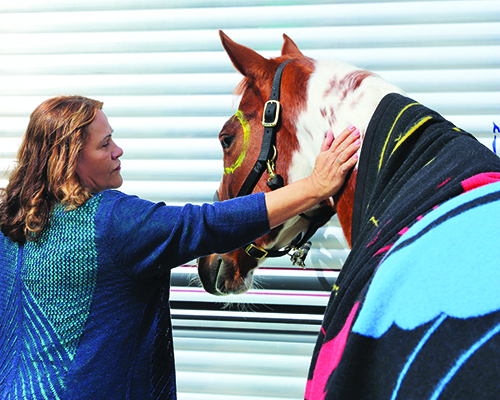
On the morning of April 25, representatives from Warm Beach Horsemanship met with Chairwoman Teri Gobin, Board of Director Mel Sheldon, and Charitable Contributions Director Marilyn Sheldon to thank them all in culturally appropriate way for the grant funds making the innovative therapy course possible. A brief introduction of what’s to come and how the children will benefit was also detailed.
“Our intent is to use the grant to run a three day trauma-informed, therapeutic program that will cater to serving eight Tulalip children currently in foster care,” explained Lisa Tremain, Horsemanship Director at Warm Beach Camp. “Through the use of horses we’ll be doing activities both mounted and on the ground that help walk the children through various stages of their healing journey. Building relationships, trust and confidence are critical pieces to the healing process that equine therapy offers.”
“In a therapeutic and safe environment, horses provide unique nonverbal feedback that can facilitate social, physical and cognitive skill development in people of all ages,” added Ginger Reitz, Therapeutic Horsemanship Coordinator.
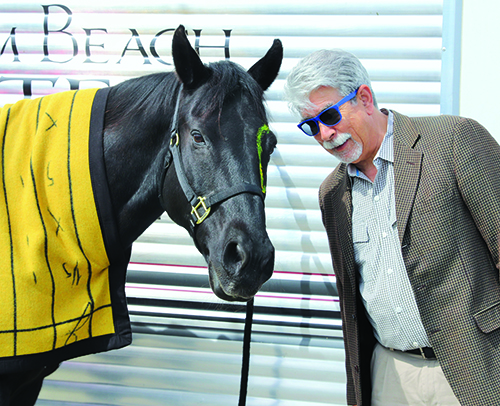
Two therapeutic horses, Mirage and Cameo, wore ‘Lightening Horse’ blankets courtesy of Eighth Generation. After making their introductions with everyone in attendance, the horses’ blankets were used to wrap Board members Teri and Mel.
“Our hands go up to you all for your good work,” stated Chairwoman Gobin. “We understand how important work like this is to help people, especially our children, heal from their own personal traumas. It’s often not easy to speak about, but it’s essential if we’re to move forward in a good way.”
By Kalvin Valdillez, Tulalip News
The transition from adolescence into adulthood is no easy feat. The teenage years are filled with triumphs and numerous setbacks. In many Native communities, kids are exposed to much more pain growing up, witnessing their loved one’s attempt to fight through adversity and find ways to cope with the years of generational trauma that is embedded in our DNA. Sometimes we find healthy outlets to work through that trauma and other times we look for ways to escape it. In addition to finding their personal identity, studying, participating in social activities and preparing for college, Native youth face many similar challenges as the average teen, but arguably at a higher extent, such as depression, violence at school or at home, the pressure to abuse drugs as well as the loss of friends or family to suicide.
Teens often need an extra bit of encouragement to help them through their periods of struggle. Many kids look to confide in somebody outside of their families, who can listen, relate and provide a positive perspective to help them keep pushing forward. Tulalip Outreach workers, Dakota (Cody) Monger and Cassandra Jimicum, are providing exactly that for several local youth of the community.
The Family Haven program, Team Outreach, is designed to provide support to Tulalip youth, helping them accomplish their goals and get things back on track. Cody works with the young men of Tulalip between the ages of thirteen and twenty-two, while Cassandra works with the young ladies between fourteen and twenty-two. The teens learn how to set, prioritize and accomplish both short and long term goals while also receiving assistance with recovery, physical and mental health, legal issues, obtaining a driver’s license, money management and resumes. The program assists high school students get re-enrolled if they dropped out of school and also helps those who wish to transfer schools within the Marysville School District.
“We will help them with everything and anything really,” says Cody “It’s like a role model program or a mentorship. Everything you can think of that our youth needs, we cover it like self-esteem, or if they’re suicidal and too scared to talk with somebody about it. It’s hard to pinpoint a specific area we work on, but we work at their pace. The biggest thing is we want to earn their trust and just be real with them, like call their bluff out or if they’re doing something wrong, tell it to them like a friend would, like dude you’re messing up.”
“They set their own goals and we go at their pace,” adds Cassandra. “I just started in February and I’ve already helped my girls with TANF, I awarded a few shoe vouchers, I got one of my girls into Drivers Ed, I got two girls enrolled back in school and helped a girl get into counseling. We have a referral process and when we get referrals, we go out and just talk with them. They tell us everything they want to accomplish and then we narrow it down to two goals and then we work on those goals and once those are completed, we work on two more.”
Both Cody and Cassandra have seen a number of success stories from the youth who participate in their groups. They explained that they proudly watched several individuals overcome personal obstacles and achieve huge feats, rising to the challenge one issue at a time and getting things done.
“I had a young man who posted every day that he didn’t want to be here,” Cody states. “It took about six to eight months pinpointing where the issue stemmed from. We had to break everything down, just so he could be happy again. Now the only thing he posts are messages saying ‘I’m doing fantastic, I’m going to school today or I love being a stepdad.’ He went from a deep, deep depression to being happy and thankful every day. He’s holding down a job, getting his GED, he became a stepfather and recently he’s started traveling more.
“Another one of my guys got in a fight with a family member and literally barricaded himself in his room for months on end and had no communication with anybody, not even his mom. Now he’s into classical music, he’s holding B’s and A’s in school and is going to be doing a few concerts in the summer.”
The Outreach workers meet one-on-one with their teens on a weekly-basis, allowing them the chance to vent about any current difficulties they are experiencing as well as celebrate any new victories. Cody and Cassandra make the experience as smooth as possible for their clients by meeting them where they’re most comfortable, whether that’s at the Family Haven office, home, school, a coffee shop or a restaurant.
Since Cody’s program has been established for a few years, many members of his group are well-acquainted with each other and have created a strong support system within the group. Cody also holds a study day on Wednesdays as well as an end-of-the week gathering, where those who wish to participate can meet up to talk about the week or participate in a physical activity together, like weight training or a pick-up game of basketball at the Marysville YMCA. As Cassandra’s program continues to gain momentum and additional participants, she also wishes to hold group gatherings throughout the week to enhance life skills with cooking and exercising classes as well as fun art and craft activities.
Currently Cassandra is guiding six young ladies through the program and Cody is serving twelve young gentlemen on a consistent basis. They want to extend a friendly welcome out to other young adults in the area who can benefit from this program, as well as to those parents and teachers who may have someone in mind that could use a helping hand, and some encouragement to reach their full potential and beyond.
“It’s important for our kids to know that there is somebody out there willing to go above and beyond for them, to help them through their darkest times,” expresses Cody. “I know sometimes it’s hard to reach out to ask for that peer support, or help in general. It’s a good feeling for them, knowing that there are people who are genuinely looking out for what’s best for them and their future.”
Nodding her head in agreement, Cassandra adds, “I feel the same way. It’s important that people know we are here to help our kids get back in school and that we are here to assist in any way we can to make sure they are successful in life.”
For more information about the Team Outreach program, please contact Family Haven at (360) 716-3284.
By Kalvin Valdillez, Tulalip News
As parents picked up their kids from the Betty J. Taylor Early Learning Academy (TELA) on the afternoon of Friday March 22, they were welcomed by the TELA administration staff as well as local programs and businesses who were stationed throughout the lobby and the conference room of the early learning academy. Twenty-six informational booths provided useful tips, ranging from nutrition to safety, in an effort to promote better overall health and wellness within the community. Parents hurried to retrieve their kids from their classrooms so they could return and participate in TELA’s seventh annual Mini Health Fair.
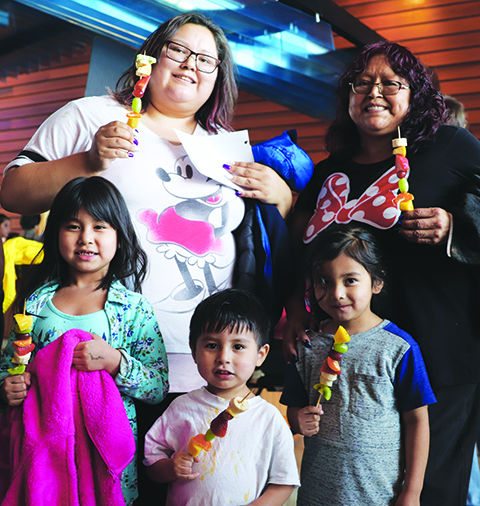 A popular event that has continued to grow over the years, the mini health fair is a fun experience for TELA students. Each booth offers hands-on interaction from the likes of the Tulalip Police and Tulalip Bay Fire departments, as well as plenty of prizes like books, toys and even animal washcloths that promote the practice of healthy habits such as reading and good hygiene.
A popular event that has continued to grow over the years, the mini health fair is a fun experience for TELA students. Each booth offers hands-on interaction from the likes of the Tulalip Police and Tulalip Bay Fire departments, as well as plenty of prizes like books, toys and even animal washcloths that promote the practice of healthy habits such as reading and good hygiene.
Perhaps the biggest highlight for the kids is sampling all the snacks. AnneCherise Jensen and the SNAP-Ed team created fruit kabobs with orange slices, pineapple, grapes, kiwi and strawberries, showing the families a new, fast and easy snack that is both delicious and nutritious. The fruit kabobs were such a smash that the SNAP-Ed booth had a line nearly the entire duration of the health fair. The TELA kitchen crew also handed out healthy snacks to the students including fruit and veggie cups as well as smoothies. 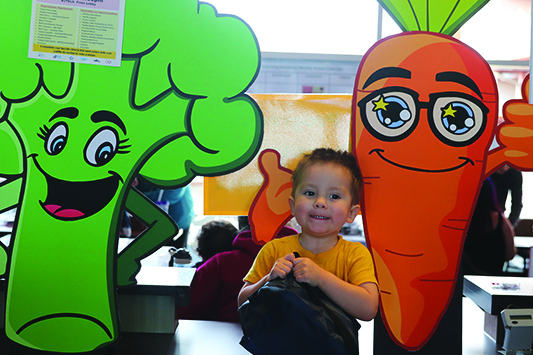
Upon checking into the mini health fair, the families received a passport. As they visited each booth, the vendors signed their passports, indicating that the families learned either a new health tip or were provided with new resources from programs such as WIC, Healthy Homes and the Snohomish County Music Project. Once their passports were filled out, the families turned them in for a chance to win a variety of prizes including gift baskets, blankets and an inflatable swimming pool – just in time for the upcoming summer season.
“We like to partner with Children’s Hospital, Red Cross, WIC, the Child Strive program and the police and fire departments as well as Disaster [Tulalip Office of Emergency Management] for those families that are in need of extra services,” explains Katrina Lane, TELA Family and Community Engagement Coordinator. “It’s been a good event to provide for the families over the years. It’s really heartwarming to see the families here with their kids, and for the kids to actually be excited about healthy things; the smoothies, the veggies, the fruit kabobs – they are just excited. It’s a good feeling to know that we’re starting them out young and that they’re getting a good idea of what health is.”
By creating a fun learning experience catered to our future leaders, the academy puts an exciting and entertaining twist on educating the community about the many benefits and the importance of good physical, mental and spiritual health.